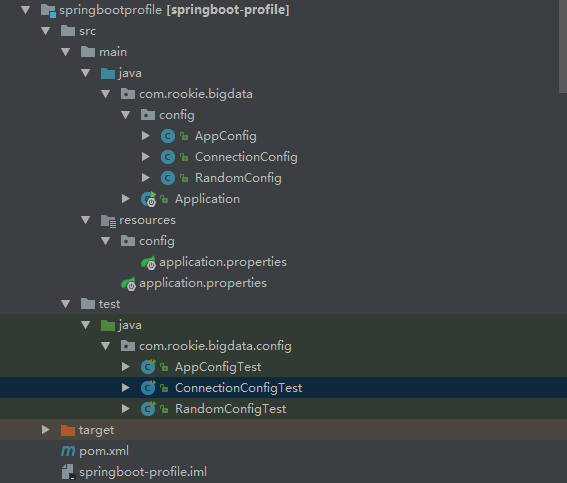springboot在加载配置文件的时候是有先后顺序的,了解加载配置文件的先后顺序,可以减少编写程序出现错误
1 springboot加载配置文件的先后顺序如下:
SpringApplication将从以下位置加载application.properties文件,并把它们添加到Spring Environment中:
- 当前目录下的
/config子目录。 - 当前目录。
- classpath下的
/config包。 - classpath根路径(root)
启动的时候,1中的配置文件优先级最高,会覆盖2,3,4中的配置信息
2 工程结构如图:

代码如下:
package com.rookie.bigdata.config; import org.springframework.beans.factory.annotation.Value; import org.springframework.boot.context.properties.ConfigurationProperties; import org.springframework.stereotype.Component; /** * springboot注入随机值 * my.secret=${random.value} * my.number=${random.int} * my.bignumber=${random.long} * my.number.less.than.ten=${random.int(10)} * my.number.in.range=${random.int[1024,65536]} * <p> * <p> * Created by on 2018/9/29. */ @Component //此注解可以省略 //@ConfigurationProperties public class RandomConfig { @Value("${random.value}") private String secret; @Value("${random.long}") private Long number; @Value("${random.int(10)}") private String numberLess; @Value("${random.int[1024,65536]}") private Integer numberRange; @Value("${name}") private String name; public String getName() { return name; } public void setName(String name) { this.name = name; } public String getSecret() { return secret; } public void setSecret(String secret) { this.secret = secret; } public Long getNumber() { return number; } public void setNumber(Long number) { this.number = number; } public String getNumberLess() { return numberLess; } public void setNumberLess(String numberLess) { this.numberLess = numberLess; } public Integer getNumberRange() { return numberRange; } public void setNumberRange(Integer numberRange) { this.numberRange = numberRange; } }
package com.rookie.bigdata.config; import org.springframework.beans.factory.annotation.Value; import org.springframework.stereotype.Component; /** * * springboot允许使用占位符进行配置 * Created by on 2018/9/29. */ @Component public class AppConfig { @Value("${app.name}") private String appName; @Value("${app.description}") private String appDesc; public String getAppName() { return appName; } public void setAppName(String appName) { this.appName = appName; } public String getAppDesc() { return appDesc; } public void setAppDesc(String appDesc) { this.appDesc = appDesc; } }
package com.rookie.bigdata; import org.springframework.boot.SpringApplication; import org.springframework.boot.autoconfigure.SpringBootApplication; /** * 应用程序启动类 * Created by on 2018/8/2. */ @SpringBootApplication public class Application { public static void main(String[] args) { SpringApplication springApplication = new SpringApplication(); //通过设置该参数禁用命令行属性添加到Environment // springApplication.setAddCommandLineProperties(false); springApplication.run(Application.class, args); } }
package com.rookie.bigdata.config; import org.junit.Test; import org.junit.runner.RunWith; import org.springframework.beans.factory.annotation.Autowired; import org.springframework.boot.test.context.SpringBootTest; import org.springframework.test.context.junit4.SpringRunner; import static org.junit.Assert.*; /** * Created by liuxili on 2018/9/29. */ @RunWith(SpringRunner.class) @SpringBootTest public class AppConfigTest { @Autowired AppConfig appConfig; @Test public void test1() { System.out.println(appConfig.getAppName()); System.out.println(appConfig.getAppDesc()); } }
package com.rookie.bigdata.config; import org.junit.Test; import org.junit.runner.RunWith; import org.springframework.beans.factory.annotation.Autowired; import org.springframework.boot.test.context.SpringBootTest; import org.springframework.test.context.junit4.SpringRunner; import static org.junit.Assert.*; /** * Created by liuxili on 2018/9/29. */ @RunWith(SpringRunner.class) @SpringBootTest public class RandomConfigTest { @Autowired RandomConfig randomConfig; @Test public void test1(){ System.out.println(randomConfig.getSecret()); System.out.println(randomConfig.getNumber()); System.out.println(randomConfig.getNumberLess()); System.out.println(randomConfig.getNumberRange()); System.out.println(randomConfig.getName()); } }
配置文件如下
my.secret=${random.value} my.number=${random.int} my.bignumber=${random.long} my.number.less.than.ten=${random.int(10)} #my.number.in.range=${random.int[1024,65536]} name=lisi #属性占位符 #当使用application.properties定义的属性时,Spring会先通过已经存在的Environment查找该属性,所以你可以引用事先定义的值 app.name=appStore app.description=${app.name} is a Spring Boot application connection.username=root connection.password=roots
3、使用@Value("${property}")注解注入配置属性有时会比较麻烦,特别是需要使用多个properties,或数据本身有层次结构。Spring Boot提供一种使用配置的替代方法,这种方法允许强类型的beans以管理和校验应用的配置,代码如下:
package com.rookie.bigdata.config; import org.springframework.boot.context.properties.ConfigurationProperties; import org.springframework.context.annotation.Configuration; import org.springframework.stereotype.Component; /** * Created by liuxili on 2018/9/29. */ //@Component @Configuration @ConfigurationProperties(prefix = "connection") public class ConnectionConfig { private String userName; private String passWord; public String getUserName() { return userName; } public void setUserName(String userName) { this.userName = userName; } public String getPassWord() { return passWord; } public void setPassWord(String passWord) { this.passWord = passWord; } }
package com.rookie.bigdata.config; import org.junit.Test; import org.junit.runner.RunWith; import org.springframework.beans.factory.annotation.Autowired; import org.springframework.boot.test.context.SpringBootTest; import org.springframework.test.context.junit4.SpringRunner; import static org.junit.Assert.*; /** * Created by liuxili on 2018/9/29. */ @RunWith(SpringRunner.class) @SpringBootTest public class ConnectionConfigTest { @Autowired private ConnectionConfig connectionConfig; @Test public void test1(){ System.out.println(connectionConfig.getPassWord()); System.out.println(connectionConfig.getUserName()); } }
属性名配置一般规则如下:
| 属性 | 说明 |
|---|---|
person.firstName |
标准驼峰规则 |
person.first-name |
虚线表示,推荐用于.properties和.yml文件中 |
person.first_name |
下划线表示,用于.properties和.yml文件的可选格式 |
PERSON_FIRST_NAME |
大写形式,使用系统环境变量时推荐 |
对于使用yml文件配置跟这里配置差不多,这里不再赘述,看个人喜好,有人喜好properties进行配置,有人喜好yml文件进行配置